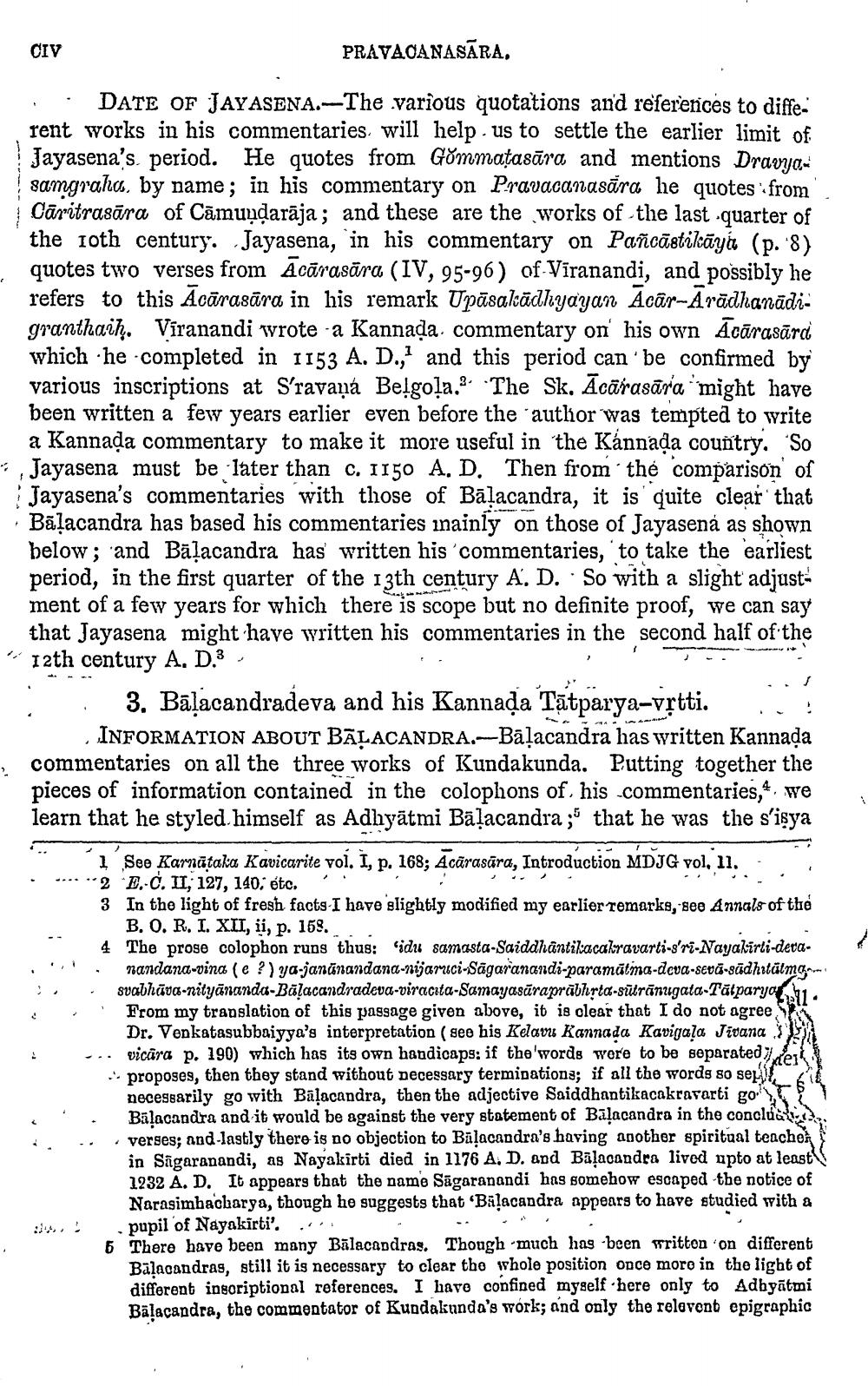________________
CIV
PRAVACANASĀRA,
.. DATE OF JAYASENA.--The various quotations and references to different works in his commentaries will help us to settle the earlier limit of Jayasena's, period. He quotes from Gõmmatasāra and mentions Dravyasamgrana, by name; in his commentary on Pravacarasāra he quotes from Cāritrasāra of Cāmuụdarāja; and these are the works of the last quarter of the roth century. Jayasena, in his commentary on Pañcāstikāyiz (p. 8) quotes two verses from Ācārasāra (IV, 95-96) of-Vīranandi, and possibly he refers to this Acārasāra in his remark Upāsakādhyayan Acar-Arādhanādigranthaih. Víranandi wrote a Kannaờa. commentary on his own ācārasārd which he completed in 1153 A. D., and this period can be confirmed by various inscriptions at S'ravaná Belgola.. The Sk. Ācārasāra "might have been written a few years earlier even before the "author was tempted to write a Kannada commentary to make it more useful in 'the Kannaďa country. So Jayasena must be later than c. 1150 A. D. Then from the comparison of Jayasena's commentaries with those of Bālacandra, it is quite clear that · Bālacandra has based his commentaries inainly on those of Jayasená as shown below; and Bālacandra has written his commentaries, to take the earliest period, in the first quarter of the 13th century A. D. So with a slight adjust: ment of a few years for which there is scope but no definite proof, we can say that Jayasena might have written his commentaries in the second half of the 12th century A. D.3
3. Bālacandradeva and his Kannada Tātparya-vrtti. it
INFORMATION ABOUT BĀĻACANDRA.Bālacandra has written Kannada 1 commentaries on all the three works of Kundakunda. Putting together the
pieces of information contained in the colophons of his commentaries, we learn that he styled himself as Adhyātmi Bālacandra ;c that he was the s'isya
·
i
1 See Karnātaka Kavicarite vol. I, p. 168; Acārasāra, Introduction MDJG vol, 11... , "2 D.-C. II, 127, 140, etc. 3 In the light of fresh facts I have slightly modified my earlier remarks, 8e0 Annals of the
B. 0. R. I. XII, 1, p. 158. 4 The prose colophon runs thus: "idu samasta-Saiddhāntikacakravarti-s'ri-Nayakirti-dera1. nandana-vina (e ? ) ya-janānandana-nijaruci-Sāgaranandi-paramātina-deva-seva-sūdhrtālmom
svabhāva-nityānanda-Bālacandradeva-viracita-Samayasūraprābhrta-sürānugata-Tātparyo . . : From my translation of this passage given above, it is clear that I do not agree
Dr. Venkatasubbaiyya's interpretation (see his Kelavu Kannada Kavigala Jivana ... vicara p. 190) which has its own handicaps: if the'words were to be separated 7e
proposes, then they stand without necessary terminations; if all the words so se 21 necessarily go with Balacandra, then the adjective Saiddhantikacakravarti go
Balacandra and it would be against the very statement of Balacandra in the conclude .. .verses; and lastly there is no objection to Balacandra's having another spiritual teacher
in Sagaranandi, as Nayakirti died in 1176 A. D. and Bālacandra lived upto at least 1232 A. D. It appears that the name Sāgaranandi has somehow escaped the notice of Narasimhacharya, though he suggests that 'Balacandra appears to have studied with a
pupil of Nayakirti'. .. 5 There have been many Bālacandras. Though much has been writton on different
Balacandras, still it is necessary to clear the whole position once more in the light of different inscriptional references. I have confined myself here only to Adhyātmi Balacandra, the commentator of Kundakunda's work, and only the relevant epigraphic




